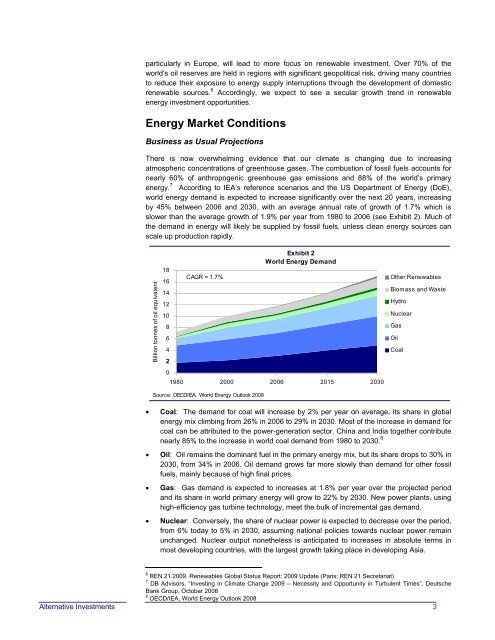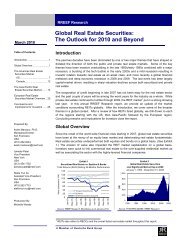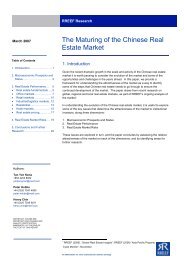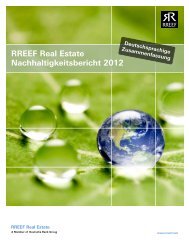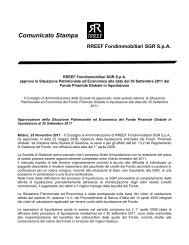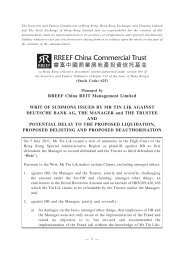Infrastructure Investments in Renewable Energy - RREEF Real Estate
Infrastructure Investments in Renewable Energy - RREEF Real Estate
Infrastructure Investments in Renewable Energy - RREEF Real Estate
You also want an ePaper? Increase the reach of your titles
YUMPU automatically turns print PDFs into web optimized ePapers that Google loves.
particularly <strong>in</strong> Europe, will lead to more focus on renewable <strong>in</strong>vestment. Over 70% of the<br />
world’s oil reserves are held <strong>in</strong> regions with significant geopolitical risk, driv<strong>in</strong>g many countries<br />
to reduce their exposure to energy supply <strong>in</strong>terruptions through the development of domestic<br />
renewable sources. 6 Accord<strong>in</strong>gly, we expect to see a secular growth trend <strong>in</strong> renewable<br />
energy <strong>in</strong>vestment opportunities.<br />
<strong>Energy</strong> Market Conditions<br />
Bus<strong>in</strong>ess as Usual Projections<br />
There is now overwhelm<strong>in</strong>g evidence that our climate is chang<strong>in</strong>g due to <strong>in</strong>creas<strong>in</strong>g<br />
atmospheric concentrations of greenhouse gases. The combustion of fossil fuels accounts for<br />
nearly 60% of anthropogenic greenhouse gas emissions and 88% of the world’s primary<br />
energy. 7 Accord<strong>in</strong>g to IEA’s reference scenarios and the US Department of <strong>Energy</strong> (DoE),<br />
world energy demand is expected to <strong>in</strong>crease significantly over the next 20 years, <strong>in</strong>creas<strong>in</strong>g<br />
by 45% between 2006 and 2030, with an average annual rate of growth of 1.7% which is<br />
slower than the average growth of 1.9% per year from 1980 to 2006 (see Exhibit 2). Much of<br />
the demand <strong>in</strong> energy will likely be supplied by fossil fuels, unless clean energy sources can<br />
scale up production rapidly.<br />
Billion tonnes of oil equivalent<br />
18<br />
16<br />
14<br />
12<br />
10<br />
8<br />
6<br />
4<br />
2<br />
- 0<br />
CAGR = 1.7%<br />
Exhibit 2<br />
World <strong>Energy</strong> Demand<br />
1980 2000 2006 2015 2030<br />
Source: OECD/IEA, World <strong>Energy</strong> Outlook 2008<br />
Other <strong>Renewable</strong>s<br />
Biomass and Waste<br />
� Coal: The demand for coal will <strong>in</strong>crease by 2% per year on average, its share <strong>in</strong> global<br />
energy mix climb<strong>in</strong>g from 26% <strong>in</strong> 2006 to 29% <strong>in</strong> 2030. Most of the <strong>in</strong>crease <strong>in</strong> demand for<br />
coal can be attributed to the power-generation sector. Ch<strong>in</strong>a and India together contribute<br />
nearly 85% to the <strong>in</strong>crease <strong>in</strong> world coal demand from 1980 to 2030. 8<br />
� Oil: Oil rema<strong>in</strong>s the dom<strong>in</strong>ant fuel <strong>in</strong> the primary energy mix, but its share drops to 30% <strong>in</strong><br />
2030, from 34% <strong>in</strong> 2006. Oil demand grows far more slowly than demand for other fossil<br />
fuels, ma<strong>in</strong>ly because of high f<strong>in</strong>al prices.<br />
� Gas: Gas demand is expected to <strong>in</strong>creases at 1.8% per year over the projected period<br />
and its share <strong>in</strong> world primary energy will grow to 22% by 2030. New power plants, us<strong>in</strong>g<br />
high-efficiency gas turb<strong>in</strong>e technology, meet the bulk of <strong>in</strong>cremental gas demand.<br />
� Nuclear: Conversely, the share of nuclear power is expected to decrease over the period,<br />
from 6% today to 5% <strong>in</strong> 2030, assum<strong>in</strong>g national policies towards nuclear power rema<strong>in</strong><br />
unchanged. Nuclear output nonetheless is anticipated to <strong>in</strong>creases <strong>in</strong> absolute terms <strong>in</strong><br />
most develop<strong>in</strong>g countries, with the largest growth tak<strong>in</strong>g place <strong>in</strong> develop<strong>in</strong>g Asia.<br />
6<br />
REN 21.2009. <strong>Renewable</strong>s Global Status Report: 2009 Update (Paris: REN 21 Secretariat)<br />
7<br />
DB Advisors, “Invest<strong>in</strong>g <strong>in</strong> Climate Change 2009 – Necessity and Opportunity <strong>in</strong> Turbulent Times”, Deutsche<br />
Bank Group, October 2008<br />
8<br />
OECD/IEA, World <strong>Energy</strong> Outlook 2008<br />
Alternative <strong>Investments</strong> 3<br />
Hydro<br />
Nuclear<br />
Gas<br />
Oil<br />
Coal


